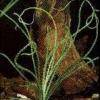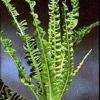Crinum thaianum
Scientific name: Crinum thaianum
Family: Amaryllidaceae
Maximum size reached under cultivation: 60 - 200 cm (23.62 - 78.74 inch)
014
Recommended pH range: 6.8 - 7.5
Recommended water hardness: 4 - 18°dGH (71.43 - 321.43ppm)
0°C 32°F30°C 86°F
Recommended temperature range: 24 - 28 °C (75.2 - 82.4°F)
Preferred propagation method: Bulb shoots
Native to: South Asia
Growth rate: Normal
Recommended substrate: Gravel
Lighting requirements: Medium
Ideal placement in tank: Background
Common Names
Onion Plant, Water Onion Plant
Origin
Crinum thaianum is native to southern Thailand, where it grows along the banks and shallow waters of rivers and streams. In nature, it is often found partially submerged, but it thrives fully submerged in aquariums.
Propagation
This plant reproduces vegetatively by producing daughter bulbs. When well-established and healthy, the main bulb will develop smaller bulbs at its base. These can be carefully separated once they are at least one-third the size of the mother bulb. When planting, make sure that the top of the bulb remains visible above the substrate to prevent rotting. New plants can then be planted in other areas of the tank.
Difficulty
Easy
Short Description
Crinum thaianum is a true aquatic plant and an excellent choice for large aquariums. It produces long, ribbon-like leaves that are both decorative and resilient—fish rarely nibble on them, making it ideal for tanks with herbivorous species. It requires a clean, nutrient-rich substrate and water column to thrive. Leaves can grow exceptionally long and may need occasional trimming at the water surface. This will not harm the plant. Due to its size, it is best used as a background or specimen plant in large aquascapes.
FAQs
-
Should I bury the whole Crinum thaianum bulb?
No, the top third of the bulb should always remain above the substrate. Fully burying the bulb can lead to rot and plant death.
-
How fast does Crinum thaianum grow?
Growth is moderate. Once established, the plant will produce long, flowing leaves, and over time, daughter bulbs will appear. CO2 and good nutrients can enhance growth.
-
Is Crinum thaianum suitable for tanks with plant-eating fish?
Yes, the tough, fibrous leaves of this plant are usually ignored by herbivorous fish, making it a good choice for such setups.
-
Can Crinum thaianum be grown emersed?
While it can survive in shallow, marsh-like conditions, it is best kept fully submerged in aquariums, where it thrives and develops its characteristic long leaves.
-
What are signs that Crinum thaianum needs more nutrients?
Yellowing or transparent leaves, slow growth, or a weak root system may indicate a lack of nutrients. Supplement with root tabs or a rich substrate.
-
Tips for long-term care
To keep Crinum thaianum healthy over the long term, ensure stable water parameters, regular substrate cleaning, and occasional root fertilization. Avoid disturbing the bulb once it has rooted, and prune older or damaged leaves close to the base to encourage fresh growth.

 Crinum calamistratum
Crinum calamistratum Crinum natans
Crinum natans